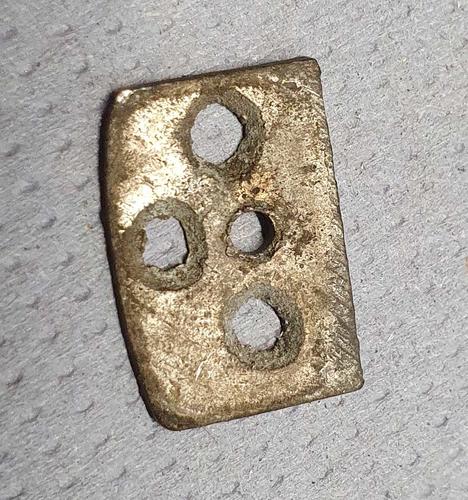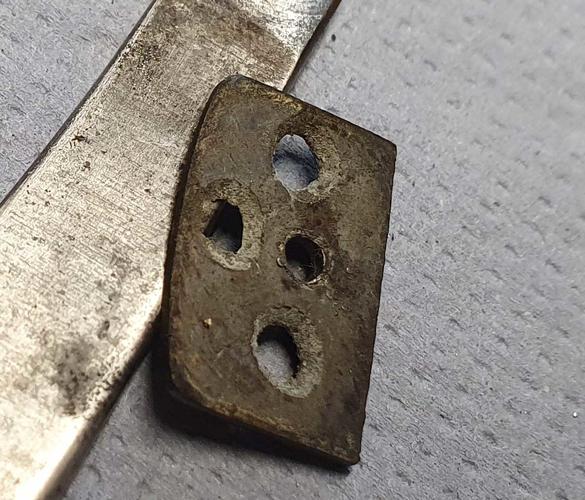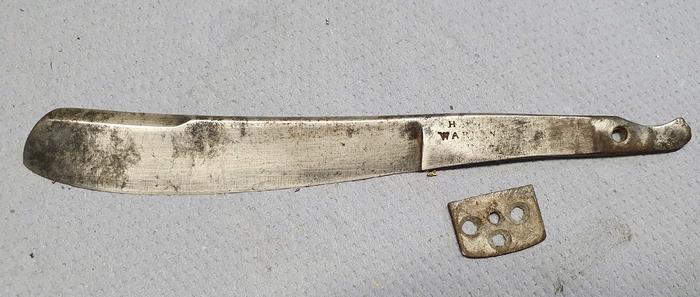Results 31 to 38 of 38
-
06-28-2021, 10:55 PM #31

If we knew the manufacturing process i think that would shed some light.
-
06-30-2021, 06:49 AM #32

Some info about wedges:
They're made of tin, just like most of the simple decorative elements pressed into the scales. Into the early 1900's, the workmen called them 'tins'.
They weren't really much in use before the tail end of the 18th century.
The earliest ones mostly have either three holes arranged around the central hole or a cutout. Some have a second pin hidden beneath the washer (well, more of a wire, since it's even thinner than 1/16th).
As near as I can tell, the practice was abandoned by the early 1820's.
Why was it done? Who knows. I don't think tin was so precious that it was to save material. It's doubtful it was to reduce weight or change the balance because the difference, especially with the 3-hole versions, is minuscule. The tapered wedge shape does the work of keeping it in place during fitment.
It may have had something to do with how they were cast in a mold. It may have been superstition, or tools from another discipline repurposed. Maybe it was just how the first guy who did it went about it and everyone else copied it. Unfortunately, without supporting documentation, there's just no way to know.
One way to know wedges and a lot of the decoration put into scales is tin is that on the scale decor, it's pretty common to come across examples of tin pest (which is when tin begins to irrevocably convert from the stable allotype to a super-fragile allotype that swells up and cracks.-Zak Jarvis. Writer. Artist. Bon vivant.
-
The Following User Says Thank You to Voidmonster For This Useful Post:
jfk742 (10-04-2021)
-
06-30-2021, 07:42 AM #33

Superstition did cross my mind.
Thanks.
-
10-03-2021, 01:46 PM #34

Working on this cute little number today. The holes look like they were punched out.. I have to conclude that the missing parts are to help with cracking & Swelling as mentioned by Zack..
The maker of this razor may never be known. It show an "H" and then a faint "A" with "Warranted" underneath. There are many makers surnames starting with HA . I do sometimes find early makes using just a surname whereas later in time, perhaps once more established they used their first names also..



-
10-17-2021, 01:36 PM #35
 "The trip is short. We try to do it in the first class." (Noiret)
"The trip is short. We try to do it in the first class." (Noiret)
-
10-17-2021, 10:43 PM #36Senior Member

- Join Date
- Jul 2020
- Posts
- 270
Thanked: 44
-
10-18-2021, 12:24 AM #37

The cost issue is to cheap for me to believe.
Most of it from what i see is the cost of paint.
The tarrif of 1816 put the added cost of lead to 3 cents a pound in 1820.
That helped a lot of Badgers from Wisconsin.
Last edited by 32t; 10-18-2021 at 12:27 AM.
-
10-18-2021, 06:58 AM #38

Maybe some were recycled or made into washers.
However I have seen some with very small pinholes which maybe could only be for swelling issues.


 90Likes
90Likes LinkBack URL
LinkBack URL About LinkBacks
About LinkBacks






 Reply With Quote
Reply With Quote


